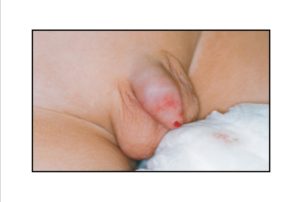These signs were consistent with the parents’ notion that the injury might have occurred when the wooden toilet seat fell and impaled onto the external genitalia while the child was passing urine directly into the toilet.
The child was able to continue to pass urine without obstruction or gross hematuria. The injuries resolved spontaneously without any specific treatment.
Discussion
Pediatric penile injuries may be accidental (Widni et al, 2011), iatrogenic and are often associated with circumcision (El-Bahnasawy and El-Sherbiny, 2002), or abusive (Hobbs and Osman, 2007) in nature. Unintentional injuries to the male external genitalia may occur from falls, during playful activities, sports, and motor vehicle or motorbike accidents (Widni et al, 2011). Male toddlers or preschool children tend to sustain genital injuries at home. The bathtub appears to be a dangerous spot when young children presenting with severe impalement injuries to the perineum are investigated (Sugar and Feldman, 2007). The toilet seat may be a hazard for the toddler graduating from toilet training (Glass et al, 2013).
The pattern of injury associated with toilet seat impalement as opposed to other kinds of genital trauma has not been described in the literature. The present case report may provide a helpful clue for the emergency physician to evaluate pediatric patients presenting with acute penile injuries. Injury largely limited to the distal part of the penis with a linear proximal border is consistent with an unintentional trauma due to a falling toilet seat.
Children suffering from toilet seat injury generally do not require specific treatment and the condition will recover invariably (Glass et al, 2013; Widni et al, 2011). Parents are instructed to observe for urinary obstruction, gross hematuria, and skin infection as potential complications, though no urethral complications have so far been reported.
It has been suggested that families with young male toddlers should avoid using toilet seats made from hard solid materials such as wood or ceramic (Philip et al, 2008), and toilet seats should be left in the lift-up position when it is not in use. Slow-close toilet seat technology will be another safety alternative (Glass et al, 2013). Epidemiologic data are needed to back up these recommendations although there is very little, if any, harms to implement such changes in most households.
References
1. El-Bahnasawy, M.S. and El-Sherbiny, M.T. (2002) “Paediatric penile trauma,” British Journal of Urology International, 90 (1) 92-96.
Google Scholar
2. Glass, A.S., Bagga, H.S., Tasian, G.E., McGeady, J.B., McCulloch, C.E., Blaschko, S.D., McAninch, J.W. and Breyer, B.N. (2013) “No small slam: increasing incidents of genitourinary injury from toilets and toilet seats,” British Journal of Urology International, 112, 398-403.
Google Scholar
3. Hobbs, C.J. and Osman, J. (2007) “Genital injuries in boys and abuse,” Archives of Diseases in Childhood, 92 (4) 328-331.
Publisher – Google Scholar
4. Philip, J., Bicha, S., Mamood, E., Sorur, M., Ananthakrishnan, K. and Irwin, P.P. (2008) “Public interest warning: should we ban wooden/ornamental toilet seats for male infants?” British Journal of Urology International, 102 (11) 1749.
Google Scholar
5. Sugar, N.F. and Feldman, K.W. (2007) “Perineal impalements in children: distinguishing accidents from abuse,” Pediatric Emergency Care, 23 (9) 605-616.
Publisher – Google Scholar
6. Widni, E.E., Hollworth, M.E. and Saxena, A.K. (2011) “Analysis of nonsexual injuries of the male genital in children and adolescents,” Acta Paediatrica, 100 (4) 590-593.
Publisher – Google Scholar



